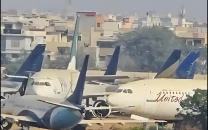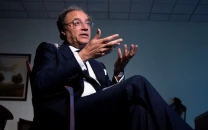The martyrs of Alamdaar Road
Importance of Alamdaar Road protests doesn’t lie in their effect on other Shias, but on larger national consciousness.

The writer is a partner at Bhandari, Naqvi & Riaz and an advocate of the Supreme Court. He can be reached on Twitter @laalshah
Stalin may or may not have said those words but he was certainly on to something. Revolutions require more than anger. They require symbols, images around which peoples’ thoughts can gather and coalesce so that the abstraction of a million deaths can become a reality.
Shias know this better than most because Shia’ism has only survived through the power of images and stories. Every Muslim can picture the events of Karbala in part because the image of Imam Hussain (RA) and his 72 companions standing firm against the might of Yazid’s army is so potent. It is these images which get revisited every Muharram: the dark and thirsty nights; the martyrdom of Hazrat Qasim, trampled by the horses of Yazid’s army; Hazrat Ali Asghar, the innocent baby pierced by an arrow; Bibi Sakina, crying as her father’s steed returns riderless to the camp; women being led through the bazaars of Damascus with their heads uncovered; Bibi Zainab defiantly lecturing Yazid before his own court.
To these images, we can now add a new tableau: the bodies of 86 people killed on Alamdaar road, their coffins placed on the open street, their mourning families refusing to bury the bodies till they get justice.
Even the name ‘Alamdaar’ is important here. The word ‘Alam’ refers to the ceremonial flag or standard carried out into battle. Alamdaar means the “standard-bearer” or the person given the responsibility of carrying the flag into battle. As in all armies, the position of flag-bearer was one of incredible honour. In the case of Imam Hussain, the ‘Alamdaar’ was Hazrat Abbas, his half-brother.
Shias believe that Hazrat Abbas died while trying to get water for Bibi Sakina, Imam Hussain’s young daughter and they revere his memory as the most faithful and courageous of Imam Hussain’s companions. That is why Shia processions always have a black flag carried in them, because that flag is a symbol of the flag of Imam Hussain and, by extension, a symbol of Hazrat Abbas (the Alamdaar). The protest on Alamdaar Road therefore not only honours the martyrs of January 10 but also references the martyrs of the past. At least for Shias, this protest is a generational call to arms. All of Shia history stems from a single deliberate act of martyrdom in the face of overwhelming brutal force. By refusing to bury their dead, the Shias of Alamdaar Road have connected their suffering with the martyrs whom they revere and the effect is profound. I like to think of myself as about as sceptical as is humanly possible. But the mourners of Alamdaar Road have managed to trump all of that.
The importance of the Alamdaar Road protests doesn’t lie in their effect on other Shias though, but on the larger national consciousness. By refusing to bury their dead, the Shias of Quetta have managed — for once — to break through our national apathy. It is a part of our culture to bury our dead immediately, just like it is a part of our culture (especially in Balochistan) for women to not be seen in public. When the ordinary Pakistani turns on his TV and sees a community united in grief, when he sees row upon row of grieving women refusing to bury and yet simultaneously honouring the serried ranks of their martyrs, that Pakistani understands in a more visceral way than ever before that something has gone fundamentally and horribly wrong in the Land of the Pure.
Please note that I am making no prediction that this massacre marks a turning point in the life of this country. More than 400 Shias were killed in sectarian killings last year and this year looks set to eclipse that mark. But, there are some encouraging signs.
The first encouraging sign is the decision by Imran Khan to not only go and participate in the protests but to unequivocally condemn the Lashkar-e-Jhangvi. This simple act of courage completely escaped not only the PPP, which remained mumbling and fumbling at the centre, but also the PML-N. Lest we forget, both parties are equally complicit in the murder of Shias. The PPP is responsible because it has chosen to pursue corruption at any expense while not giving a damn about issue of governance and security. The PML-N is responsible because it has taken the lead role in the ‘mainstreaming of hate’ by entering into electoral alliances with parties openly identified with sectarian hate. A third responsible party is the army. For at least the past two decades, the faujis have chosen to act through militant proxies for the sake of supposedly greater strategic gains while turning a blind eye to the sectarian havoc spread by those proxies. And as for the religious parties, the less said about them the better.
The second encouraging sign is the spontaneous appearance of protests across the country. From Quetta to Karachi to Islamabad to Lahore, people have been gathering. At the beginning, the protests were small. But they are continuing. And they are spreading.
You may say that a few hundred or even a few thousand protesters will have no effect. But the important aspect of the protests is that they expose our political parties. It is an open secret that the PML-N has been flirting with sectarian parties. Till date, that flirtation was justified on practical grounds. Trust us, was the argument: once we get power at the national level, then we’ll take on the killers. That hypocrisy now stands exposed. Whether or not the hypocrisy ends is up to the PML-N. But let me tell the Sharif brothers that everybody is now watching a lot more closely than before.
Popular movements are about an idea catching fire in the minds of the masses. Two years ago, a fruit-seller in Tunisia set the entire Arab World on fire when he burnt himself alive in protest. I don’t know if the martyrs of Alamdaar Road will change the course of this country. But along with other Pakistanis, I stand with my head bowed in grief at their sacrifice. Dear God, let it not be in vain.
Published in The Express Tribune, January 15th, 2013.















COMMENTS
Comments are moderated and generally will be posted if they are on-topic and not abusive.
For more information, please see our Comments FAQ